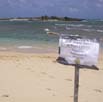 |
| HOME > Field Accounts |
ISLET FIELD ACCOUNTS
Follow the interns and volunteers through their work on the offshore islets. Click on the photos to link to a photo gallery for each visit.
|
|
> 19 Feb 2007: Moku'au'ia (Goat Island), O'ahu
> 29 Feb 2007: Mokulua, O'ahu
> 28 Mar 2007: Kaohikaipu (Black Rock), O'ahu
> 2-3 April 2007: Po'opo'o, Lana'i
> 2-3 April 2007: Pu'u pehe (Sweetheart Rock), Lana'i
> 5 Apr and 7 Apr 2007: Moku'au'ia (Goat Island), O'ahu
> 5-7 Apr 2007: Mokoli'i (Chinaman's Hat), O'ahu
> 29 Apr 2007: Kapapa (Mokukapapa), O'ahu
> 3-4 May 2007: Lehua, Kaua'i and Ni'ihau
> 9 May 2007: Moku'au'ia (Goat Island), O'ahu
> 12 May 2007: Mokoli'i (Chinaman's Hat), O'ahu
> 29-31 May 2007: Molokini, Maui
> 29-31 May 2007: Kaemi, Maui
> 29-31 May 2007: Hulu, Maui
> 1 Jun 2007: Moku'au'ia (Goat Island), O'ahu
> 8 Jun 2007: Moku'au'ia (Goat Island), O'ahu
> 15 Jun 2007: Moku'au'ia (Goat Island), O'ahu
> 22 Jun 2007: Moku'au'ia (Goat Island), O'ahu
> 29 Jun 2007: Moku'au'ia (Goat Island), O'ahu
> 6 Jul 2007: Moku'au'ia (Goat Island), O'ahu
> 18 Jul 2007: Moku'au'ia (Goat Island), O'ahu
> 24 Jul 2007: Moku'au'ia (Goat Island), O'ahu
> 31 Jul 2007: Moku'au'ia (Goat Island), O'ahu
> 7 Aug and 30 Aug 2007: Kapapa (Mokukapapa), O'ahu
> 7 Aug and 30 Aug 2007: Kaohikaipu (Black Rock), O'ahu
> 8 Aug 2007: Moku'au'ia (Goat Island), O'ahu
> 17 Aug 2007: Moku'au'ia (Goat Island), O'ahu
> 17 Aug 2007: Mokoli'i (Chinaman's Hat), O'ahu
> 24 Aug 2007: Moku'au'ia (Goat Island), O'ahu
> 8 Sep 2007: Mokauea, O'ahu
> 10 Sep 2007: Moku'ae'ae, Kaua'i and Ni'ihau
> 18-20 Sep 2007: Mokapu, Moloka'i
> 18-20 Sep 2007: 'Okala, Moloka'i
> 21 Sep 2007: Mokoli'i (Chinaman's Hat), O'ahu
> 22 Sep 2007: Moku'au'ia (Goat Island), O'ahu
> 24 Sep 2007: Kaohikaipu (Black Rock), O'ahu
> 24 Sep 2007: Manana (Rabbit Island), O'ahu
> 14-16 Oct 2007: Mokoli'i (Chinaman's Hat), O'ahu
> 17 Oct 2007: Popo'ia (Flat Island), O'ahu
> 20-21 Oct 2007: Kapapa (Mokukapapa), O'ahu
> 25 Oct 2007: Moke'ehia, Maui
> 26 Oct 2007: Mokupipi, Maui
> 27 Oct 2007: Pu'uku (Pu'uki'i), Maui
> 1 Nov 2007: Po'opo'o, Lana'i
> 1 Nov 2007: Moku mana, Maui
> 2 Nov 2007: Pu'u pehe (Sweetheart Rock), Lana'i
> 2 Nov 2007: Ki'ei, Lana'i
> 10 Nov 2007: Mokauea, O'ahu
> 1-2 Dec 2007: Kaohikaipu (Black Rock), O'ahu
> 9 Feb and Feb 11 2008: Manana (Rabbit Island), O'ahu
> 15 Feb 2008: Mokuho'oniki, Moloka'i
> 16 Feb 2008: Moku manu, Moloka'i
> 16 Feb 2008: Kanaha, Moloka'i
> 19 Mar 2008: 'Alau, Maui
> 20 Mar 2008: Mokuhuki, Maui
> 26 Mar 2008: 'Ale'ale, Kaho'olawe
> 26 Mar 2008: Pu'u koa'e, Kaho'olawe
|
|
Moku'au'ia (Goat Island) 29 Jun 2007
|
|
Trip Goal: To assist DOFAW biologists in an attempt to eradicate Yellow Crazy Ants from the islet using Mokoli'i Islet as a control (no bait used). Using the results of our bait preference trials, a new bait was made specifically for controlling Yellow Crazy Ants in Hawai'i. This ant species has disrupted seabird colonies and ecosystems elsewhere in Hawai'i and around the tropics, but eradication has been troublesome. A successful eradication on Moku'auia would be great step in restoring these fragile island ecosystems to their natural state. Accomplishments: Over the course of 3 months, we completed 2 ant bait applications and conducted intensive monitoring of the ant and seabird populations. We were able to significantly reduce ant numbers, but not eradicate them entirely. However, as a result of our experiment, seabirds were able to survive and successfully hatch chicks on the island. No seabird chicks survived on our control islet (Mokoli'i), where ant bait was not applied. More importantly, we have learned from the project and will readjust the bait amounts and timing and will hopefully eradicate the ants soon.
|

Photo Gallery
|
Intern Account: Malia:
"On the most recent trip to Moku'auia I was certain that the ant population would decrease again. While checking plot 1, we found about 3 ants where a nest of more than one thousand was before. However, while running the transect accross the island we found that the ants are moving towards the center of the islet. While surveying the eastern edge of the islet, I rarely saw ants every 10 steps. Kim and Jason, who were surveying the middle, saw many more ants than I did. After the spam, honey, and peanut butter traps had been out for one hour, we found that in the drier areas where there were no ants before, ants were found. We think that the ants may be onto our plan or are perhaps relocating their nests. On this trip we found many seabird eggs that were cracked open by bugs. In one case the entire side of an egg was cracked open and cockaroaches, worms, ants, and beatles were inside. The seabirds did not seem to be bothered by the ants, since in previous trips we had seen birds potentially blinded from the ant's secretions. However, we did find one dead bird lying on its back. We could not find the cause of its death since we could not see any external injuries or evidence of some kind of attack on it. I hope that the next trip will bring better news of the ant population."
|
|
|

